|
< Earlier Kibitzing · PAGE 3 OF 3 ·
Later Kibitzing> |
| Mar-05-09 | | kevin86: Fine finish by Steinitz-wouldn't have solved this one in hours--- |
|
| Mar-05-09 | | Aurora: 36 Rf6 is a nice step aside to clear square e6 for the queen. |
|
Mar-05-09
 | | TheDestruktor: <rubato> <thought Qe5...think is winning move too> The difference here is that the move 36.Qe5 would leave the second rank immediately unprotected. Then black would have the chance to play 36.Qe5 Qc2+ 37.Kg3 Qb1, threatening ...Qg1+ and perpetual. |
|
| Mar-05-09 | | ClassZPlaya: I must have a blind spot in this position. I still don't see the win after 36. Rf6 Rg6 (instead of 36. ... h5?) 37. Qe7+ Rg7 38. Qe6 Rg6 39. Qf7+ Rg7. What am I missing? |
|
| Mar-05-09 | | ClassZPlaya: Nevermind ... I just realized that in my line above, after 39. ... Rg7 40 Rxh6+! Kxh6 41. Qh5 is mate. |
|
| Mar-05-09 | | CHESSTTCAMPS: <Frankly: Is there any difference between Rd6 Qe6 and Rf6 Qe6? If not, then I'm content. If there is, please explain why Rf6 works but Rd6 not.> It turns out that either method of doubling queen and rook on the 6th is highly effective. In my initial post, I picked the latter method (which turned out to be the game continuation) because: 1. I foresaw a mating net with Q on e6 (controlling g8) and R on h6.
2. Like agb2002, I thought it was needed to keep the queen out of g6.
3. The rook on f6 also keeps the black queen out of f4, and I thought that was necessary to free the white queen for participation in the attack. As it turns out in the line that <dzechiel> posted, on move 36 black does not have time to shift the queen to set up a perpetual check on the c1-f4 diagonal because the white king has a protected spot on h3 as well as g3. This win was possible because white has a relatively strong pawn shelter around his king and black does not. |
|
| Mar-05-09 | | ZUGZWANG67: I don' t see any sort of mechanical solution, only a quiet (again!) move.
My solution would be based on the following diagrams: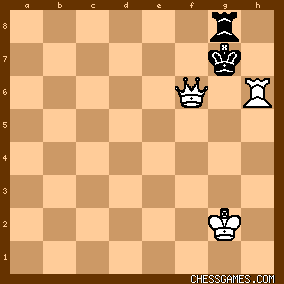
click for larger view
with B to move, which is mate (#1);
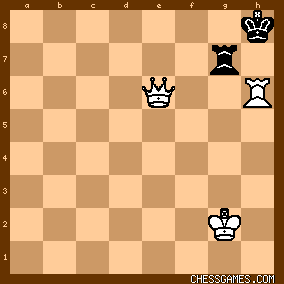
click for larger view
with B to move, which wins the R if 1. ...Rh7 2.Qf6+ Kg8 3.Qg6+ Kf8, or is mate if 3. ...Rg7 4.Qe8# (#2) 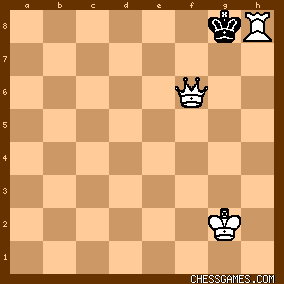
click for larger view
with B to move, mate (#3).
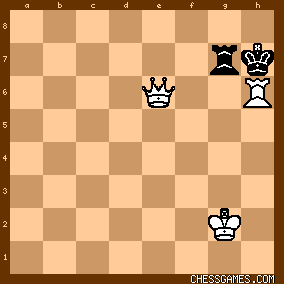
click for larger view
with again B to move being mate #(4).
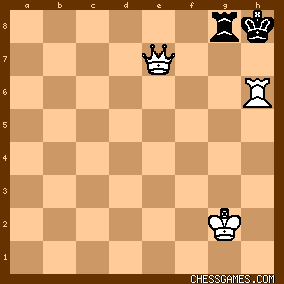
click for larger view
with again B to move, mate #(5).
Thus, I would go for 36.Rf6, with the idea of 37.Qe6, threatening to reach diagram number 4 on the very next move. Of course, Black could disturb with 37. ...Qbx+ 38.Kg3, but that only delays matters. If Black plays 36. ...Rg6 37.Qe7+ Rg7 38.Qe6 Kh8 39.Rxh6+, it brings things to diagram number 2. Or 36. ...Rc7 37.Qe6 Kh8 38.Rxh6+ Kg7 39.Qf6+ Kg8 40. Rh8#, which is diagram number 3, though it' s still not too late for Black to go back to back to number 4 by 37. ...Rc7 38.Rxh6#. In case of 36. ...Rg8 37.Qe6, Black has the choice between going either for diagram number 1 or play something like 37. ...Kg7 38.Qe7+ Kh8 39.Rxh6#, reaching number 5. That' s the kind of analysis that can make you look like a genius or an heretic. Time to check... (GULP!) |
|
| Mar-05-09 | | ZUGZWANG67: (LOL) Quiet move !
:0D |
|
| Mar-05-09 | | skemup: I was considering both Rd6 and Rf6 unfortunatelly i did not notice how imortant is placing Q on e8 square.
For example 36.Rd6 Rg6 37.Qe7+ Rg7 38Qe8! with (Rxh6+ to follow) if 38..Rg8 39.Qf7+ wich forces Rxh6+ anyway. |
|
| Mar-05-09 | | ZUGZWANG67: <Once: Difficult to see because it is not a check, direct threat, sacrifice or capture.> Hi Once.
My opinion (I may be wrong, though), is that such a quiet move, as I call 36.Rf6, is probably one of the easiest to find OTB. That is because you don' t sacrifice anything, thus avoiding any risk of breaking your nose by means of an erroneous calculation. Instead You simply try to improve your position at the expense of the opponent' s weaknesses, as one should do most of the time in many games. But one must admit that when comes the time to see it in a puzzle, where one always expects to find a stunning sac, it is rarely the kind of move that comes to mind. Peace!
|
|
| Mar-05-09 | | Once: <ZUGZWANG67> Wise words, as always, my friend! I fully agree. OTB, quiet moves are quite easy to find. Indeed, our usual problem is that our OTB moves are too quiet. For me, at least! But in CG land, we look for the stunning tactic - the sacrifice, the unanswerable threat, the forcing move. And that is where I found today difficult. A puzzle normally calls out for a puzzle type move ... this is more subtle. Of late CG.com has been treating us to several challenging puzzles where the key move is far from obvious. Some may criticise, but I am enjoying the shift of gear. |
|
| Mar-05-09 | | ZUGZWANG67: <Once: Of late CG.com has been treating us to several challenging puzzles where the key move is far from obvious. Some may criticise, but I am enjoying the shift of gear.> I do agree, as I think it is a good idea to keep us on the look out for the unsuspected. |
|
| Mar-05-09 | | ZUGZWANG67: Or rather, unexpected... |
|
| Mar-05-09 | | ruzon: I tried working backwards, seeing that a rook sac on h6 allowed ♕h5#, and all I could do was wish my queen was on e8 instead of e2. I also saw that moving my rook off the 6th rank let Black out with ♕g6, but I could not fuse those two ideas together with ♖f6 or ♖d6. |
|
| Mar-05-09 | | Alphastar: 36. h4 (my idea) also wins, although not with the idea I had in mind. The text move is also faster. |
|
| Mar-05-09 | | whitebeach: For some reason this one came easy to me. I saw 36. Rd6 first, then decided that Rf6 looked even better, on the rather flimsy grounds that then I wouldn't have to worry about any complications from 36 . . . Rf7. The key to the position is that after either white rook move black is very close to being in zugzwang. The fact that he had to resort to 36 . . . h5 shows how close. I think white could have won fairly easily simply by taking the pawn. But of course the game continuation is better. |
|
| Mar-05-09 | | Marmot PFL: This took quite a while. I looked at a lot of moves before Rd6, and didn't find Rf6 at all although the lines are similar. |
|
| Mar-05-09 | | gallard: Good puzzle, made possible by Black's terrible move 35. ...Rg7. 35. ...H5 would have been significantly better but still leaves Black with a somewhat inferior position (could still hope for a draw though with a bit of luck). |
|
| Mar-05-09 | | WhiteRook48: 40...Kxh6 and then what?
-A Patzer |
|
Mar-05-09
 | | Jimfromprovidence: For the record, my previous comment needs revision. I stated that <Specifically, if white plays 34 a4 first, black can follow correctly with 34...Rg7.> This is an incorrect statement. If 34 a4 Rg7 then white is winning with 35 Qf3 (seeing Qf8) .

click for larger view34 g3 is a very good move because it does prevent the queen check on e4. But it leads to major material gain only if black plays Rg7 on moves 34 or 35. My bad.
|
|
Mar-05-09
 | | offramp: Superb stuff. Schlechter was always a hard man to beat. |
|
| Mar-05-09 | | Lord Osiris: WhiteRook48, to answer your question heres how the line would go: 36.Rf6...h5
37.Qe6...Qc2+
38.Kg3...Rg6
39.Qf7+...Rg7
40.Rh6+...Kxh6
and the killer final move is 41.Qxh5++ |
|
| Mar-05-09 | | whitebeach: <Alphastar: 36. h4 (my idea) also wins> How so, after 36 . . . gxh4 with the threat of . . . h3+ followed by queen checks on the first rank? I don't find the win but would be interested to see your analysis. |
|
| Mar-06-09 | | whitebeach: One last observation: Both of these great players might well have spotted the decisive rook sac given in the annotations (38...Rg6 39.Qf7+ Rg7 40.Rh6+!). I guess we'll never know. But Schlecter didn't need to see the sac in order to be persuaded to resign, and Steinitz didn't need to see it in order to justify entering his line of play, because after 38...Rg6 39.Qf7+ Rg7 white has a routine forced win that both masters would easily have calculated even if they didn't spy the sac: 40. Qxh5+ Kg8 41. Qe8+ Kh7 42. Rf8 and mate follows very shortly no matter how black plays. |
|
| Mar-15-09 | | patzer2: For the Thursday, March 5, 2009 puzzle solution, Steinitz's 36. Rf6!! prepares to double the Queen and Rook on the sixth or eight rank for a decisive attack on Black's helpless King. If 36...Rg6, then 37. Rf8 Rg7 38. Qe8!  makes for the decisive infiltration on the eighth rank. Otherwise, the game continuation allows for a mating attack by doubling the heavy artillery (Queen and Rook) on the sixth rank. makes for the decisive infiltration on the eighth rank. Otherwise, the game continuation allows for a mating attack by doubling the heavy artillery (Queen and Rook) on the sixth rank. |
|
 |
 |
|
< Earlier Kibitzing · PAGE 3 OF 3 ·
Later Kibitzing> |





